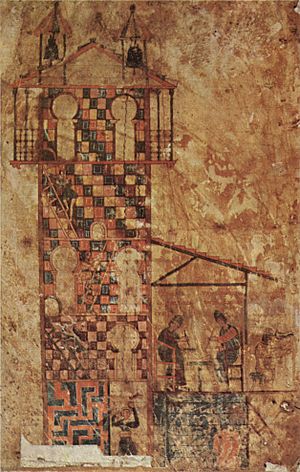Tábara Beatus facts for kids
The Tábara Beatus is a very old, special book from the 10th century. It's a type of book called an illuminated manuscript, which means it was written and decorated by hand. This book contains a famous text called the Commentary on the Apocalypse, written by a monk named Beatus of Liébana.
The Tábara Beatus was made in a place called the San Salvador de Tábara Monastery in Spain. Today, you can find it in the National Historical Archive in Madrid. Sadly, only eight of its original one hundred beautiful pictures are still left.
Contents
What is the Tábara Beatus?
The Tábara Beatus is a handwritten book from the year 970. It's known for its amazing artwork and detailed writing. Books like this were very important before printing presses existed. Monks spent many years carefully copying and decorating them.
The text in the Tábara Beatus is written in two columns. It uses a special old writing style called Visigothic minuscule. You can also find notes written in Arabic in the margins. This shows that some monks in the monastery were Mozarabic, meaning they were Christians who lived under Muslim rule and spoke Arabic. The book also has big, fancy letters at the start of sections.
Who Made the Tábara Beatus?
We know a lot about who made this book because of a special note inside it. This note, called a colophon, says the book was finished on July 29, 970.
- Emeterius was the main scribe, meaning he was in charge of the writing.
- A monk named Monnius was the copyist. He did the actual writing of the text.
- The beautiful pictures and decorations were done by an artist named Magius. Some people think Magius might be the same artist who worked on another famous book called the Morgan Beatus. Sadly, Magius passed away while still working on the Tábara Beatus.
The Tábara Beatus was copied from an older book that is now lost.
How Was the Book Kept Safe?
Over time, the Tábara Beatus moved to different places. One of its later owners was Ramón Alvarez de la Braña, a librarian in Leon. From his collection, the book went to the School of Diplomacy in Madrid. Finally, it found its permanent home in the National Historical Archive.
See also
In Spanish: Beato de Tábara para niños


